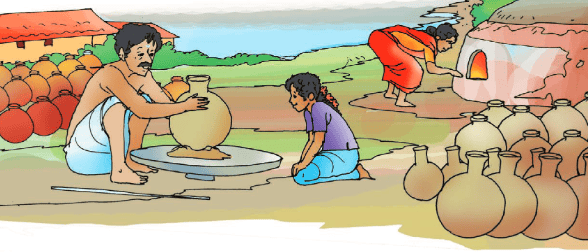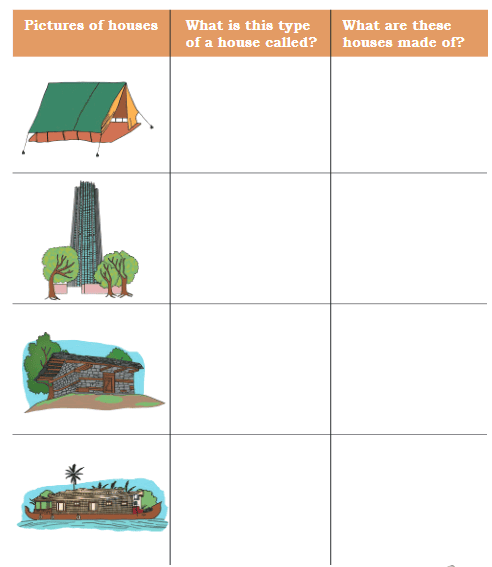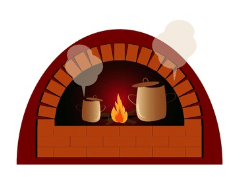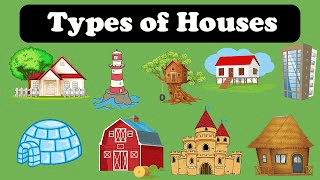Making Things NCERT Solutions | EVS Class 3: The World around us (Our Wondrous World) PDF Download
Discuss (Page 137)
Q1: What are pots used for?
Ans: Pots are used for various purposes such as storing water, cooking food, planting flowers, and decorative purposes.
Q2: What other kinds of things do potters make?
Ans: Potters make a variety of items including cups, plates, vases, bowls, gullaks (piggy banks), birdbaths, and decorative pieces.
Q3: Why is the pot baked in a kiln?
Ans: The pot is baked in a kiln to harden the clay and make it durable. The high temperature in the kiln removes moisture from the clay, strengthens the pot, and makes it suitable for use.
 Activity 1 (Page 137)
Activity 1 (Page 137)
- Visit a potter in your neighbourhood with your parents or elders in the family.
- Observe how the potter works on the stone wheel or the potter’s wheel.
- Have you wondered how clay takes a beautiful shape on a spinning wheel?
- Which of the products made by a potter do you use at home?
- Draw some of the products that you have seen at the potter’s place in the box given below.
Ans: Students are encouraged to attempt this on their own.

Activity 2 (Page 138)
Make Your own clay
(Do this activity with the help of elders)
Collect soil from wet or muddy places.
Remove any big pebbles or stones, sand, leaves or parts of plants from it using a net or sieve.
Put this soil in a flat vessel filled with water.
After a few days, throw away the water that stays on top.
Now make dough that you can shape into a ball.
Ans: Students are encouraged to attempt this on their own.
Activity 3 (Page 139)
Arrange the images in the correct order by numbering them from 1 to 5.
 Ans:
Ans:

Activity 4 (Page 140)
Q: The following are some patterns with repeating shapes and lines.

Ans: Students are encouraged to attempt this on their own.
Q: Decorate the given objects with patterns.
 Ans: Students are encouraged to attempt this on their own.
Ans: Students are encouraged to attempt this on their own.
Pottery in Indian Pottery (Page 141)
There are some beautiful forms of pottery from different parts of India.
Tick the ones that have patterns on them.

Ans: 
Discuss (Page 144)
Q1: Are all houses made of bricks?Ans: No, not all houses are made of bricks. Houses can be made from a variety of materials depending on the region, climate, and resources available.
Q2: What do you think are other materials used to build houses?
Ans: Other materials used to build houses include wood, mud, straw, bamboo, stone, concrete, and metal. In some places, people use natural materials like grass, leaves, and cow dung for building houses.

Write (Page 144)
Q1: Why do you think mud houses are better for the environment?Ans: Mud houses are better for the environment because they are made from natural materials that are easy to find nearby. This means we don't need to use big trucks to bring in materials from far away. Mud houses also break down naturally and don’t create waste. They help keep the house cool, so we don't need to use as much electricity.

Q2: Look around at the houses in your neighbourhood. What are the houses made of?
Ans: The houses in my neighbourhood are mostly made of bricks and concrete. Some also have parts made of wood, glass, and metal for windows and doors.
Activity 5 (Page 145)
Look at the pictures below. Guess the name of each type of house. Fill it in the given table below.

Ans: 
Activity 6 (Page 146)
Make a Wall
Make some bricks using a matchbox mould, small paper boxes, clay or atta (Dough). Stack them in these two arrangements shown in the drawing.
Which one is sturdier?
Which one falls more easily when pushed?

Ans: Students are encouraged to attempt this on their own.
Discuss (Page 146)
Q: Are there any safety rules at home?Discuss (Page 146)
Ans: Yes, some safety rules at home include:
- Not playing with sharp objects.
- Not touching electrical outlets.
- Informing an adult about dangerous items.
- Not climbing on furniture.
- Keeping floors clear to avoid tripping.

Q: Do you have any safety rules at school?
Ans: Yes, some safety rules at school include:
- Walking in the hallways.
- Following fire drill instructions.
- Keeping the classroom tidy.
- Not pushing on the playground.
- Using playground equipment safely.
Let us reflect (Page 147)
A. Write
Q1: What is the process of pot making?
Ans: The process of pot making involves several steps:
- Collecting clay and making it wet.
- Adding enough water to get the right consistency.
- Pounding and kneading the clay to make it like dough.
- Placing the clay on a stone wheel and shaping it by spinning the wheel.
- Allowing the shaped pots to dry.
- Moving the dried pots into a kiln (a very hot fire inside a big oven) to bake them.

Q2: How do artists get ideas for their arts?
Ans: Artists often get ideas for their art from nature. They observe patterns on plants and animals, such as the spots on a leopard or the stripes on a squirrel, and use these patterns in their art.
Q3: What is a kiln?
Ans: A kiln is a very hot oven used by potters to bake their pots. The high temperature in the kiln hardens the clay, making the pots durable and ready for use.
Q4: What are houses made of?
Ans: Houses can be made of various materials including bricks, mud, grass, wood, and cow dung. In some areas, people use natural materials to build traditional mud houses which are cool inside and eco-friendly.
Q5: You may also try to find videos on YouTube that show the process of things being made. Write down the steps in as much detail as possible.
Ans: [This would require watching specific videos, so here’s a general answer based on typical processes.] For example, the process of making a pencil involves:
- Cutting cedar wood into thin slats.
- Grooving the slats to hold the graphite lead.
- Placing the graphite lead into the grooves.
- Gluing another slat on top.
- Cutting the slats into individual pencils.
- Painting and adding erasers.
B. Draw and colour any three different kinds of houses.
Ans:

C. Discuss
Q1: Why do we have different kinds of houses?
Ans: We have different kinds of houses because of varying climates, available materials, cultural practices, and economic conditions. For example, mud houses are common in warm areas as they keep the interior cool, while brick houses are sturdy and durable in various climates.
Q2: Why do people wear helmets at construction sites?
Ans: People wear helmets at construction sites to protect their heads from falling objects, debris, and other hazards. Helmets help prevent head injuries and ensure safety while working. 
Q3: What would happen if there were no patterns in nature?
Ans: If there were no patterns in nature, the world would look very different and less organized. Patterns help in the identification of species, camouflage, and attraction of pollinators. They also inspire human art and design, adding beauty to our surroundings.
D. Interview
Q1: Interview someone who makes crafts or toys in your locality. Share the information in the class.
Ans: [Requires conducting an interview, so here’s a general answer.] I interviewed a local craftsman who makes wooden toys. He shared that he uses natural wood, hand tools, and traditional techniques to create intricate designs. He gets his ideas from nature and local culture, and he enjoys creating toys that bring joy to children.
Q2: Find out how some commonly used objects like pencils, erasers, pens, and notebooks are made. Ask your elders.
Ans: Pencils are made from wood and graphite. The wood is cut into slats, grooved to hold the graphite, glued together, and then shaped into pencils. Erasers are made from rubber or synthetic materials and are attached to the pencil ends. Pens are made from plastic or metal and contain an ink reservoir and a writing tip. Notebooks are made from paper sheets bound together, often with a cardboard cover.
|
30 videos|128 docs|14 tests
|
FAQs on Making Things NCERT Solutions - EVS Class 3: The World around us (Our Wondrous World)
| 1. How can students use the concept of making things in their daily life? |  |
| 2. Why is it important for children to learn how to make things on their own? |  |
| 3. What are some examples of simple things that children can make by themselves? |  |
| 4. How does the process of making things help children in their overall development? |  |
| 5. How can parents encourage their children to engage in making things? |  |
















